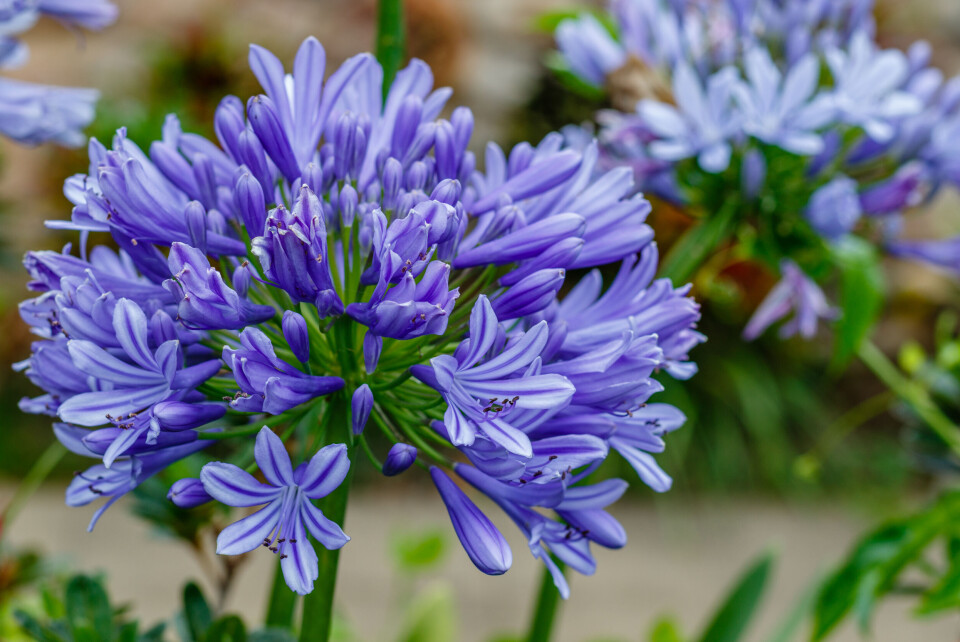-
Comment: Le Tour de France does not export the best of French values
Columnist Nabila Ramdani notes that the fabled race is to start in the UK in 2027, bringing with it a questionable legacy
-
Letters: France needs a new strategy to stop spam calls
Connexion reader says the new legislation will not work just as previous rules failed
-
What you should do to your garden in France in spring
Weeding, pruning, sowing, preparing the lawn…here is how to welcome sunnier days
France garden tips: try agapanthus, it is hardier than you think
The evergreen types are ideal for a Mediterranean climate, coming as they do from the western and eastern cape in South Africa

The fastest way to get anyone drooling over plants – whether a gardener or non-gardener – is to show them a picture of the blue Himalayan poppy (Meconopsis betonicifolia). Seed merchants and gardening magazines know this, frequently choosing the poppy or equally gorgeous Anemone ‘Mr Fokker’ as cover stars.
However, the sad truth is that few of us with French gardens can give this plant the acid soil, coupled with summer cool and moistness, it demands.
Read more: Dream of a detached house with garden fades in France
Forming the ideal garden
As a poppy addict, I am currently asking myself why I have stubbornly ignored the fact that I might achieve the same effect on a hot August day with the clear blues of agapanthus. After all, they are a pretty drought-tolerant crew and team perfectly with the grasses that look so good in our dry, late-summer gardens, such as Miscanthus, Helictotrichon, and Panicum.
They do suffer from a frost-tender reputation. In an alternative gardening universe – beyond the shores of sunny France – they are subjects to be popped into pots, cosseted in the greenhouse in winter, and then wheeled out of shelter again in spring. And, since they are splendidly architectural plants, with gorgeous strap-shaped leaves, they are worth all that trouble.
Or perhaps you garden on a sheltered balcony in a large city like Paris or Lyon and are looking for plant drama and architectural shapes? You can’t go far wrong with pots of the ‘fan palm’ (Chamaerops humilis), non-running bamboo such as Fargesia rufa, and a bevy of pots displaying the glorious late-summer blue umbels of agapanthus.
There’s a common gardening myth that says they won’t flower well unless the roots are congested. Not true – make sure you move them to larger quarters (about two sizes bigger than the original pot) when they are looking a little pot-bound.
A feed with a high-potash fertiliser (such as tomato feed) every two to three weeks will be appreciated. Perhaps water twice a week as opposed to every second day, depending on how much sun your balcony gets?
Read more: French garden diary: New roses bred for resistance
The different varieties
For the open garden, there are far more varieties hardy to at least -10°C (or even lower) than you may have imagined, and their number increases each season as breeders concentrate on the hardiness factor.
Be aware that there are both deciduous (hardy) and evergreen (tender) agapanthus, and it’s the deciduous types that survive a cold winter, coming as they do from mountainous areas of South Africa. Unfortunately, since they come from summer rainfall areas, they tend to dislike wetter winter soils. Best to plant in raised areas or to dig plenty of grit/sharp sand into the ground at planting.
The evergreen types are ideal for a Mediterranean climate, coming as they do from the western and eastern cape in South Africa, where the majority of rain falls during the winter months. They tend to be more drought-tolerant than the deciduous types.
I will leave those of you gardening in the south of France to these ‘tender’ pleasures (forever denied to me!) and suggest a few harder agapanthus cultivars you might like to try if your winter temperature sinks to -6°C or lower.
I have not included white or pale colours, although agapanthus offer these aplenty. Mention is also made of plants that settle into the garden quickly and flower in their first year since there are many top varieties around that take time to make themselves at home.
‘Northern Star’ (to 75cm; hardy to -10°C) is a glorious new cultivar, dark-purple in bud, opening to deep blue flowers with darker purple streaks down the centre of the petals; very free-flowering. ‘Flower of Love’ (to 50 or 60cm; first-year flowering; hardy to between -12 and -10°C). Very new, but already awarded the coveted AGM from the Royal Horticultural Society. A standout dark blue for the garden or in pots – note that it’s quite a low-growing plant. Extremely free-flowering.
‘Donau’ (to 80cm; hardy to -12°C) is very large-flowered, with light blue petals striped a rich violet-blue. ‘Brilliant Blue’ (to 60cm; hardy to -9 or -10°C) large flowers of one the bluest of blues to grace your garden. Dark blue ‘Midnight Star’ (synonym ‘Navy Blue’; to 60cm; hardy to -15 to -10°C) and dark purple ‘Midnight Dream’ (to 70cm; dark purple, almost black; hardy to -5 to -10°C) are both tough new large-flowered cultivars.
Finally, the old, much-loved variety ‘Bressingham Blue’ (to 80cm, flowers in the first year; hardy to -15°C), from Alan Bloom’s famous garden in Norfolk, is a strong, clear blue. Since its beauty comes with a tough-boot label, any garden is incomplete without it.
Are there striking agapanthus cultivars that have survived low temperatures in your garden? Please let us know via news@connexionfrance.com
Related links
French vegetable gardens offer fresh job prospects
‘Tax on France’s vegetable gardens would be another Macron scandal’
Jardins Ouverts: Visit a Dordogne chateau and an English-style garden
























